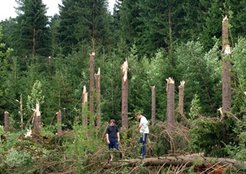What we really need to know about forests
International conference in Jena from 9-11 October on forest biomass information.
Forests not only represent an important natural resource, but are also an explosive topic, especially in the context of global climate policy, due to their function as a carbon store and source. Satellite data and the detailed information derived from it on the spatial distribution and changes in forest biomass are therefore essential for various interest groups in both politics and industry.

In addition to scientists working on the derivation of forest biomass information from satellite data, the conference will focus on the users of these remote sensing products. ‘There are a large number of sectors in which biomass information is required. We want to learn from their practical experience and identify and collect their requirements,’ reports Prof Dr Christiane Schmullius, holder of the Chair of Remote Sensing and initiator of the meeting. For example, national forestry authorities, consulting companies and international organisations such as the World Wide Fund for Nature (WWF) or the Forest Stewardship Council (FSC) are very interested in meaningful information on the spatial distribution of forest biomass and its changes. Climate modellers are also dependent on remote sensing specialists and their biomass calculations. ‘Biomass is still a big unknown in the carbon cycle. But it is an important component in our models, for example in order to be able to make precise predictions about the carbon cycle and thus climate development,’ explains Dr Markus Reichstein, newly appointed Director of the MPI-BGC, who is organising the conference at the MPI-BGC together with his colleague Dr Christian Beer.
In addition to presentations, discussion forums will focus on the requirements of users and the existing methods and algorithms used by remote sensing experts. The resulting breakdown of user requirements and the remaining research deficits will provide an important planning basis not only for academic researchers but also for space agencies and commercial satellite operators, who will also be represented at the meeting.
The ESA GlobBiomass Meeting is being held for the first time in this form. ‘It offers a unique opportunity to come together with biomass experts from research and practice to further advance a coordinated, international concept for global biomass mapping and monitoring,’ says remote sensing expert Schmullius, emphasising the importance of the conference. The long-term goal of the Jena organisers is to establish a GlobBiomass programme supported by ESA and coordinated with NASA, as already exists in a similar form for other important land surface and climate parameters, such as GlobWetland for wetlands, GlobSnow for snow cover and GlobCover for land use. ‘This is the only way we can secure the data basis necessary for monitoring global forest biomass in the long term and help to reduce the inaccuracies of climate models,’ emphasises Prof Schmullius.
